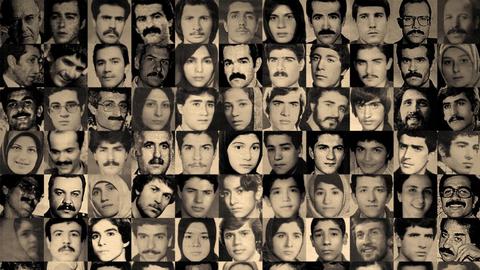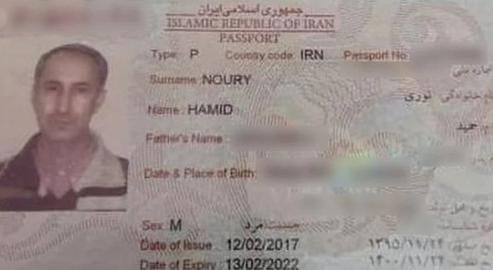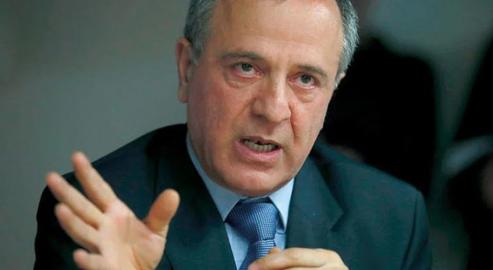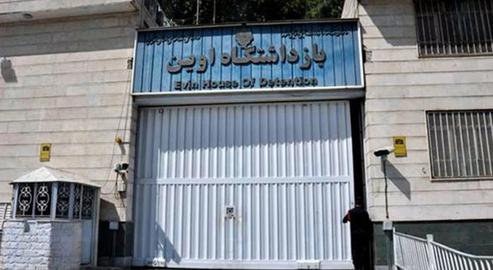In a month’s time, an Iranian assistant prosecutor said to have overseen the 1988 massacre of political prisoners in Tehran’s Gohardasht prison will go on trial in Sweden. The case against Hamid Nouri is set to get under way on August 10 in Stockholm, with the 8,000-page case file now featuring the testimonies of more than 100 plaintiffs and witnesses.
In June this year, an audio file featuring the voice of a man identified as Hamid Nouri was released by Saeed Malekpour, a former political prisoner. The speaker declared “victory” while speaking to a Swedish court, stating: “Inform the hypocrites that they will have a painful torment ahead: those who take infidels as friends and guardians instead of believers.”
Ahead of the formal proceedings opening, IranWire hosted a Clubhouse meeting in the presence of Iraj Mesdaghi, a human rights activist who played a key role in Nouri’s arrest, Reza Moini, the head of Reporters Without Borders’ Iran-Afghanistan desk, activists Mehdi Aslani, Taghi Rahmani and Mahnaz Ghezellou, Roya Boroumand, executive director of the Abdorrahman Boroumand Center for Human Rights in Iran, ex-political prisoner Saeed Malekpour, and Mohammad Hossein Aghasi, an Iranian lawyer.
Several of those present including Mesdaghi, Moini, Aslani, Rahmani and Ghezellou were held prisoner in the 1980s themselves and saw friends and family members killed in the mass executions of late summer 1988. During the meeting, those present examined the details of Hamid Nouri's case.
***
Gohardasht prison in the 1980s. Hamid Nouri, real name Hamid Abbasi, beats a prisoner to a pulp with his own fists and kicks him on the ground. The prisoner is blindfolded, and Nouri presumes he can’t see who is conducting the torture. He then has them thrown into solitary confinement for months on end.
During the beating, though, his ID card has fallen out of his pocket. The prisoner, Iraj Mesdaghi, caught sight of it from under the blindfold. Years later and after his release, he would publish Nouri’s true identity in his book about the experience.
For the past 20 months it has been Hamid Nouri’s turn to be handcuffed, held in custody and subject to judicial procedure. This time, though, the prison is not under the control of the Islamic Republic’s state-sanctioned torturers but the Swedish authorities, and the case against him is a well-founded one. Next month, Mesdaghi and other Iranians brutalized on his watch are scheduled to testify against him in court.
In Gohardasht in the late 1980s, Hamid Nouri supervised the prison, called the names of the prisoners destined for execution, lined them up, took them to their deaths, and after each round of systematic hangings and shootings, celebrated with abandon. He offered sweets to prisoners in the so-called "corridors of death" while their bodies were bloodied from torture, and mocked their visible pain at the executions of their comrades and friends.
In April 1988, months before the killings started Nouri was working directly under Mohammad Moghiseh, then-assistant public prosecutor at Evin and Gohardasht prisons. That month they began calling prisoners into a room and asked them if they would be willing to vote in the third parliamentary elections under the Islamic Republic. They wrote down each person’s answers, and depending on what they said, some of the prisoners were taken away to be savagely beaten with cables in what appears to have been a prelude to the mass murders to come.
This was just the beginning. At the conference hosted by IranWire this week, Iraj Moghiseh told those present: "Hamid Nouri himself, along with members of the death squad and the Revolutionary Guards, personally attended the [1988] executions.
“Prisoners were kicked in the abdomen before being hanged. In Gohardasht mosque and the theater auditorium, ropes were hung up, the prisoners were made to stand on chairs, and the chairs were kicked out [from under them] to make them fall and suffocate.
“On September 12 and 13, 1988, the killings became public knowledge. In the corridor of death, we were threatened; they said they would give the final kick to the chair. Hamid Nouri and Naserian [the then-name of Judge Moghiseh] insisted that they would ‘drown us in our feces’: at the time of hanging, if the intestines are full, they generally empty."
After the 1988 massacre, Hamid Nouri stayed on in the Tehran prison system was responsible for obtaining forced confessions as the prison's superintendent. Mehdi Aslani, another former detainee, can still hear his voice in his mind.
"Hamid Nouri acted as a footman and courier of death that summer,” he said. “I don’t know how the others who met Hamid Abbasi in the corridors of death and in Gohardasht Prison felt when they saw his photo. He summoned the Behkish family to send them for execution, and Mehdi Fereydoni, Farshad Esfandiari, Bijan Bazargan, Mansour Najafi, and Majid Vali, and... The bones of thousands of young souls. I say from the vantage point of a witness that bringing Hamid Nouri to trial is a victory. I and other survivors will be able to point the finger of blame at him as one of the killers, in a fair trial, when they ask us to do so."
Mehdi Aslani met Hamid Nouri on August 28 and 31, after Nouri had separated the prisoners into groups of ten in order to send some of them to the death squads. The condemned groups were taken down to the lower floors of the prison and never seen again. “The hope of all like myself,” Aslani said, “is a fair trial and a fair sentence for His Majesty the Murderer."
The Trial of Hamed Nouri, Not the Islamic Republic
"His Majesty the Murderer" is a nickname picked up over the years by several of the most prominent perpetrators of the 1988 massacre. Besides Nouri, another of them is Ebrahim Raisi, Iran’s president-elect, who sat on the so-called “death panel” for Evin and Gohardasht Prisons.
Hamid Nouri’s trial is now slated to begin five days after Raisi assumes the presidency. This has prompted some observers to regard the court case in Sweden as a symbolic trial of the wider Islamic Republic. But not all critics of the Iranian regime share this view; for Reza Moini, “Hamid Nouri’s case is Hamid Nouri’s case, in the eyes of the law all over the world.
“When dealing with any crime, the definition of that crime, the legal proceedings, and the outcome, be it a conviction or an acquittal, have consequences – all of which belong to Hamid Nouri. If is acquitted, it means the evidence was not enough for the court to convict him; not that did not play a role in the killings.
“The European courts and the American system are defendant-oriented. This means that there must be sufficient evidence to convict the accused. From this perspective, having so many witnesses in court could shed light on the darkness; that is, on a part of the history of Iran that has been practically excised from its history, not only in terms of narrative but also in terms of the people of that period. The trial is a great achievement.”
In Moini’s view, while important, the Hamid Nouri trial will be just one step in addressing the wider crime of the 1988 massacre and the United Nations should consider setting up an independent fact-finding inquiry into the crimes committed that summer, and the perpetrators.
Hamid Nouri’s Coded Message to the Iranian Regime
Since his arrest by Swedish police in November 2019, Hamid Nouri has consistently denied his role in human rights abuses and extrajudicial killings in the 1980s. But in the same message to the Swedish court ahead of the trial opening, he also repeatedly insisted he was a “trustworthy soldier” of Iran. What, the Clubhouse panel was asked, was the purpose of this?
Iraj Mesdaghi noted that Nouri’s recorded outburst had an emphasis on fidelity – that was, on not having divulged any official secrets about his time in the Tehran prisons. “We seek justice, and not revenge. Mothers, families and plaintiffs want to know what happened to their loved ones. For this reason, he wanted to send the message that he had not said anything [about the crimes] and that they [the Iranian regime] could be comfortable. He also said they could count on him because he was ‘smart’ and ‘alert’: that is, begging for help."
After Hamid Nouri was arrested, Mesdaghi and other activists issued a public call for victims and their families to testify. Many chose not to, either for their own safety or out of concern for their families in Iran. Nevertheless, the witnesses now number more than 100.
Some families are also holding onto hope that when Hamid Nouri takes the stand, they may finally learn where their loved ones are buried. "If Hamid Nouri speaks in court,” Aslani said, “he could help us decipher what we have been calling the Khavaran cenetery.
“He took the inmates into the corridor. He took them to the death squads. All those who came out had one of a few destinies; one was to be transported away in refrigerated trucks. Hamid Nouri knows where those trucks were headed. If he speaks, we might decode one of the most important locations, which has since become a memory. Khavaran was not the only cemetery."
Swedish Court Case the First Step on a Long Road to Justice
Sedigheh Haji Mohsen’s brother Hossein Haji Mohsen was hanged in Gohardasht Prison in September 1988, on the first day of the “second wave” of killings of leftist prisoners. Hossein had already been sentenced to 15 years in prison, of which he had served six and a half, when he was taken away to be executed.
“I am happy about the trial of Nouri and will testify as a plaintiff on October 18,” Sedigheh Haji Mohsen told the Clubhouse room. “No matter how far his trial goes, it is a victory for us as long as it frightens these criminals into not being able to move easily in Europe and America."
Hamid Nouri himself is unlikely to be permitted to speak during the trial until November, when his defense is currently set to get under way. The case will be landmark in testing the principle of universal jurisdiction, under which foreign states can try the perpetrators of crimes against humanity overseas, and will be watched by thousands: from the victims and their families, to lawyers and activists, to the Islamic Republic itself.
Related coverage:
Date Set for Trial of Iranian Accused in 1988 Massacre
Justice at Last? 1988 Massacre Suspect Arrested in Sweden
A Move For Justice Around the World
Raisi's Crimes Against Humanity Will Haunt his Presidency
1988: The Crime that Won't Go Away
Ebrahim Raisi: The Case for the Prosecution
Fresh Calls for Mousavi to Face Criminal Investigation Over 1988 Massacre
visit the accountability section
In this section of Iran Wire, you can contact the officials and launch your campaign for various problems



























comments